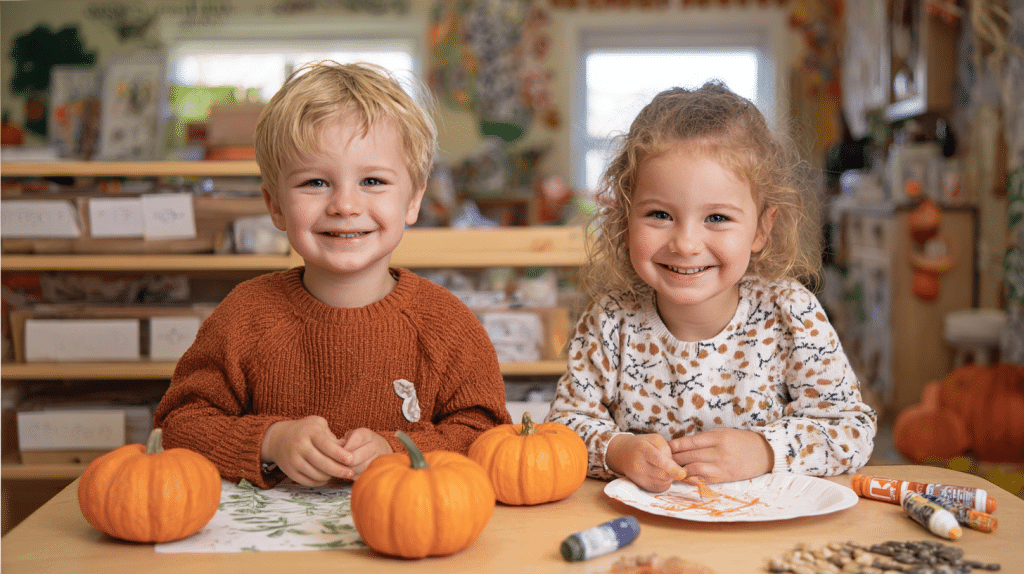Fall is the perfect season to bring learning and play together, and pumpkins make it even more exciting.
If you’re searching for creative ways to engage little ones, these pumpkin activities for preschool are simple, fun, and full of hands-on learning.
From crafts and sensory play to cooking, early science, and storytime, pumpkins can spark curiosity while building important skills.
These activities are easy to set up, safe for small hands, and work well in both classrooms and at home. Read this collection to see which pumpkin preschool activities will bring the most smiles and learning this fall.
Easy Pumpkin Crafts for Preschoolers
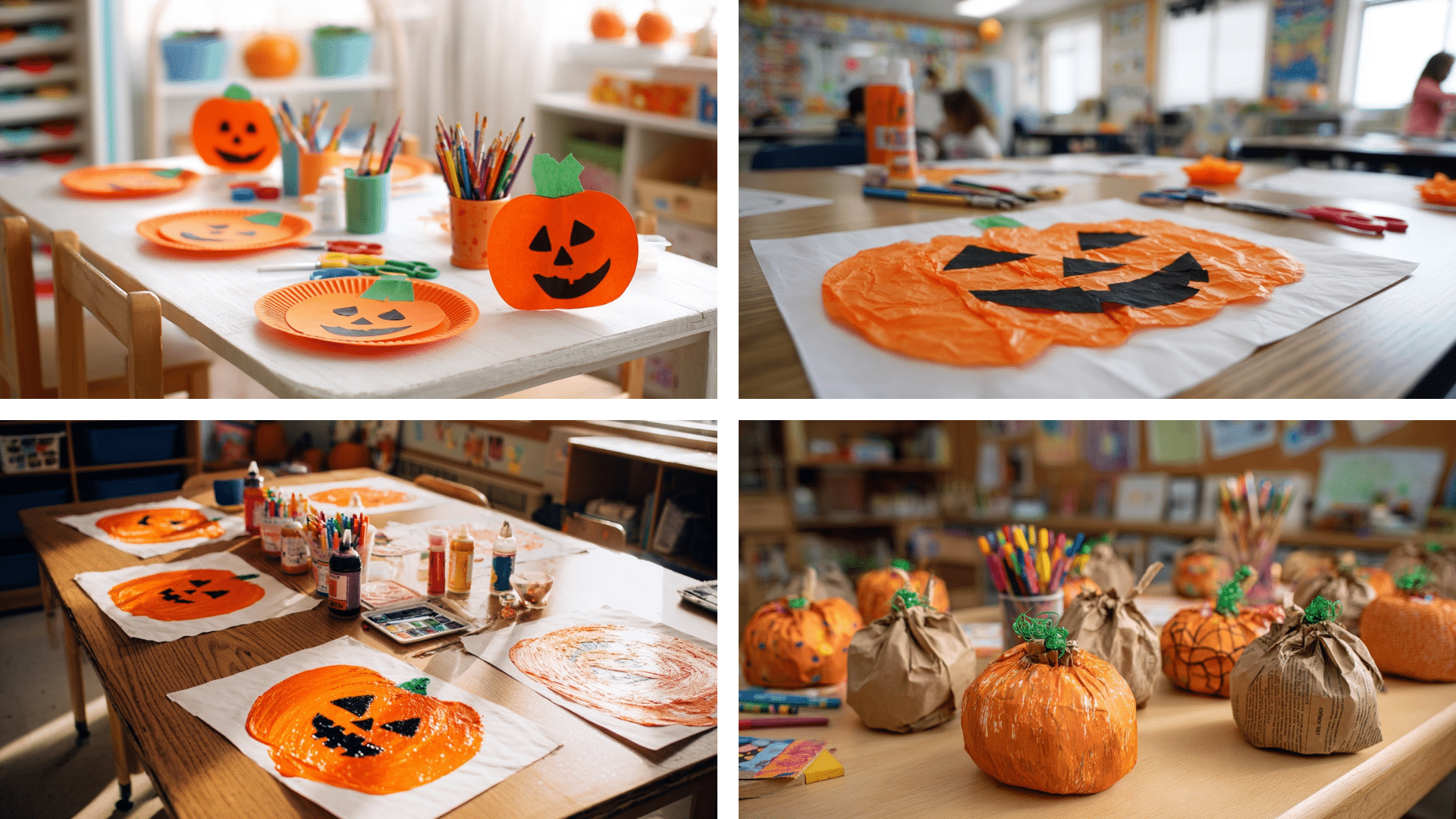
Simple crafts are a fun way for preschoolers to learn about pumpkins while practicing creativity and hand skills. These activities use everyday materials and encourage fine motor development.
1. Paper Plate Pumpkin
This craft is simple and uses materials most classrooms already have. Give each child a paper plate, orange paint, and a brush.
After painting, let them add a green construction paper stem and black cutouts for eyes, nose, and mouth.
You can also use yarn or tissue paper for texture. This activity helps preschoolers practice fine motor skills, creativity, and color recognition while making their own pumpkin.
2. Tissue Paper Jack-o’-Lanterns
Provide kids with an outline of a pumpkin on sturdy paper. Tear or cut orange tissue paper into small pieces, then have children crumple and glue them inside the outline.
Add black paper cutouts to form a jack-o’-lantern face. This hands-on craft strengthens finger muscles, supports hand-eye coordination, and gives preschoolers practice with spatial awareness.
It’s also a fun way to introduce Halloween themes without using sharp tools.
3. Puffy Paint Pumpkins
Mix shaving cream with white school glue and orange food coloring to create puffy paint. Kids can use brushes or their fingers to spread the paint onto pumpkin outlines or cutouts.
Once dry, the pumpkins have a raised, soft texture. Preschoolers enjoy the sensory aspect of squishy paint, while also practicing brush control and hand strength.
Add details with black paper shapes or markers to complete each pumpkin face.
4. Paper Bag Pumpkin
Stuff a small brown paper bag with crumpled newspaper or tissue to give it shape.
Twist the top and secure it with a green pipe cleaner or ribbon to make a stem. Children can paint the bag orange or decorate it with markers.
This activity encourages problem-solving, as kids figure out how to fill and shape the pumpkin. It also builds fine motor coordination while tying in creative design.
Pumpkin Sensory Play Ideas
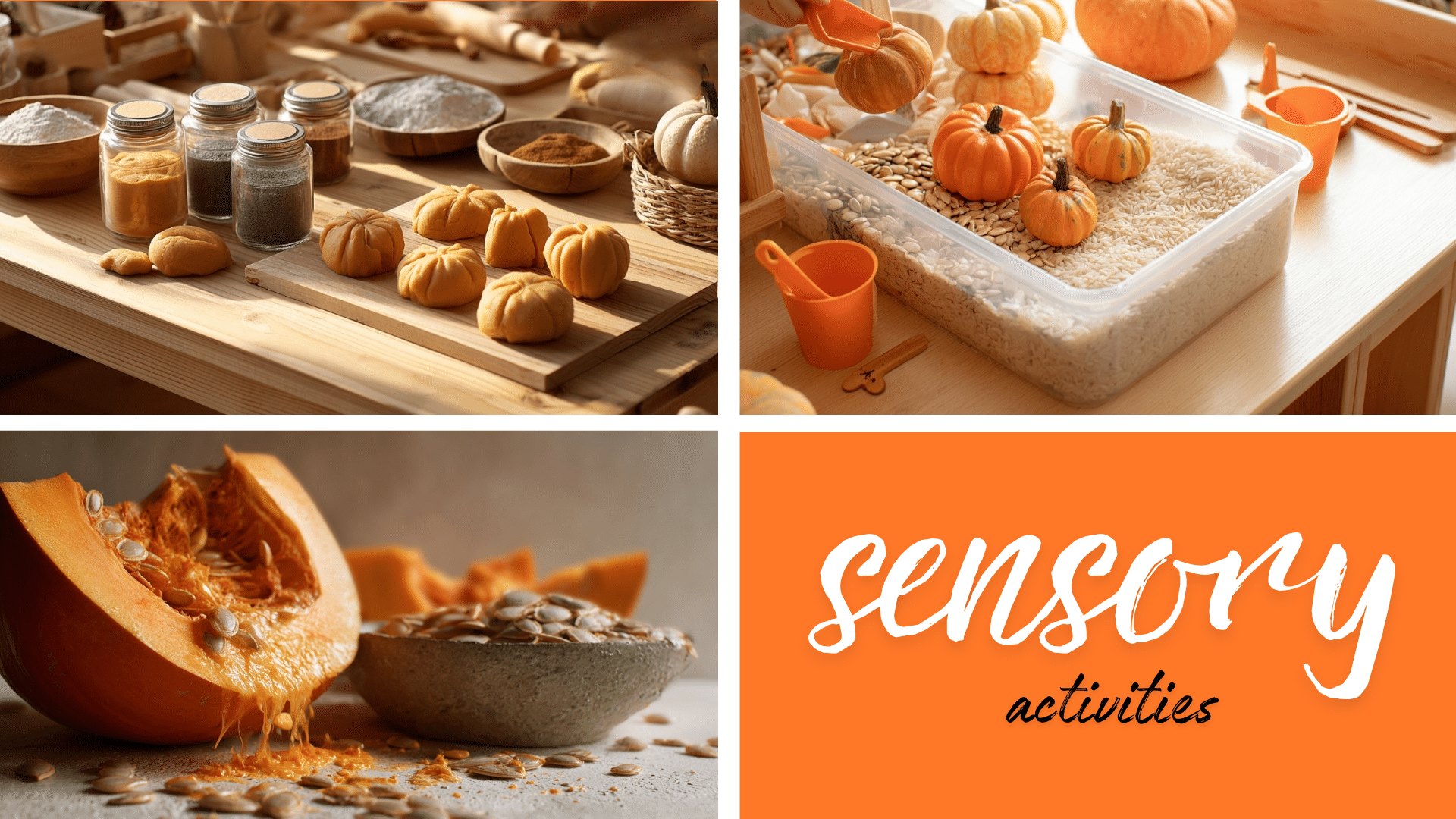
Sensory play with pumpkins gives children the chance to touch, smell, and learn textures in meaningful ways. These activities build language skills while supporting sensory development.
5. Pumpkin Spice Playdough
Homemade pumpkin spice playdough is soft, scented, and perfect for fall. Mix flour, salt, cream of tartar, oil, water, and pumpkin pie spice to create a batch.
Kids can roll, squish, and shape the dough into pumpkins or other fall items.
The smell of spices engages their sense of smell, while the squishing builds hand strength and fine motor skills.
Encourage children to describe how it feels and smells, adding new words to their vocabulary.
6. Pumpkin Sensory Bin
Fill a large bin with dried rice, beans, or pumpkin seeds, then add small plastic pumpkins, scoops, and cups.
Children can dig, pour, and scoop, finding different textures. You can also hide letter or number cards to mix sensory play with early learning.
This activity helps with hand-eye coordination and motor planning. It also encourages language growth as children talk about what they feel, hear, and see while playing in the bin.
7. Inside a Pumpkin
Cut open a pumpkin and let preschoolers scoop out the seeds and pulp. Ask them to describe what they feel – slimy, sticky, or smooth.
They can also notice the pumpkin’s smell and sound when seeds drop into a bowl. This activity stimulates multiple senses at once while strengthening vocabulary and descriptive language.
Handling seeds and stringy pulp supports fine motor skills, while the natural curiosity of seeing inside a pumpkin encourages observation and conversation.
Pumpkin Science & STEM Activities
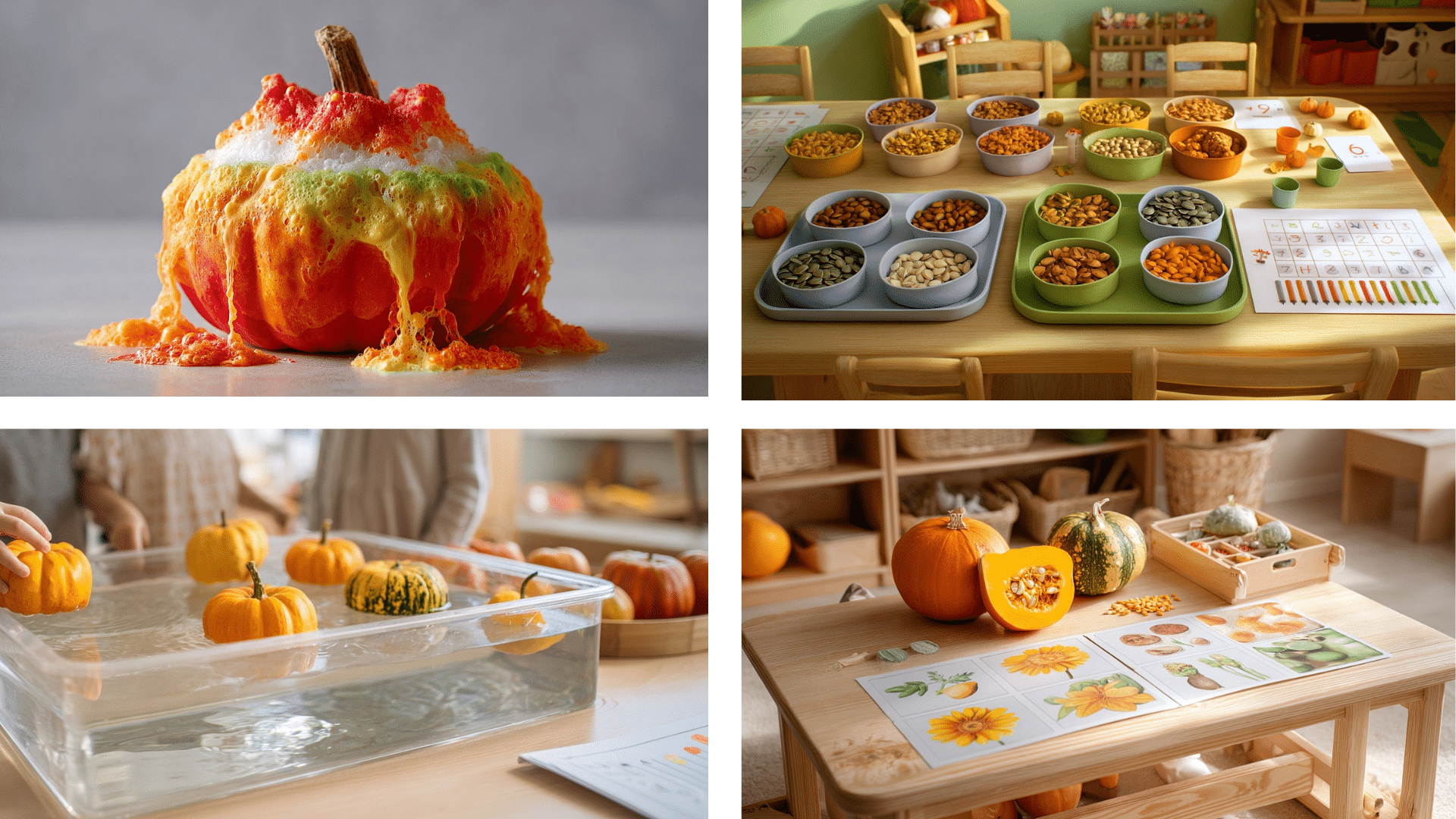
These activities let preschoolers learn about pumpkins through simple experiments and hands-on learning. They combine curiosity with early science and math skills in a fun way.
8. Pumpkin Volcano Experiment
Carve out a small pumpkin, place baking soda inside, and pour in vinegar mixed with food coloring. Watch the “lava” bubble out of the pumpkin.
This introduces chemical reactions in a safe, playful way. Ask children to guess what will happen before adding vinegar, then compare results.
Extend learning by charting their predictions versus what they observed, helping them connect cause and effect. This activity supports curiosity, observation, and simple hypothesis building.
9. Sink or Float with Pumpkins
Fill a tub with water and give children pumpkins of different sizes. Ask them to predict if each pumpkin will sink or float, then test together.
Record the results on a simple chart, reinforcing math and early science skills. Talk about why even big pumpkins can float due to air inside.
This activity builds observation skills, introduces buoyancy, and encourages preschoolers to use words like heavy, light, float, and sink while comparing objects.
10. Pumpkin Seed Sorting & Counting
After opening a pumpkin, let children collect seeds and sort them into groups. They can sort by size, shape, or color.
Provide cups or trays for organization, then help them count each group. Extend the activity by creating simple bar charts or number cards to match quantities.
This activity helps preschoolers practice sorting, categorizing, and one-to-one correspondence. It also connects hands-on experimenting with early math concepts in a playful, real-world way.
11. Pumpkin Life Cycle Activity
Use pumpkin life cycle printables alongside a real pumpkin to show each stage from seed to plant, flower, and fruit. Let children handle seeds and compare them with pictures.
Help them arrange the stages in order, then draw or paste them onto a chart. Ask questions like, “What comes first? What comes next?” to build sequencing skills.
This activity teaches growth cycles, reinforces vocabulary, and can be extended by planting seeds for observation.
Pumpkin Math & Literacy Games
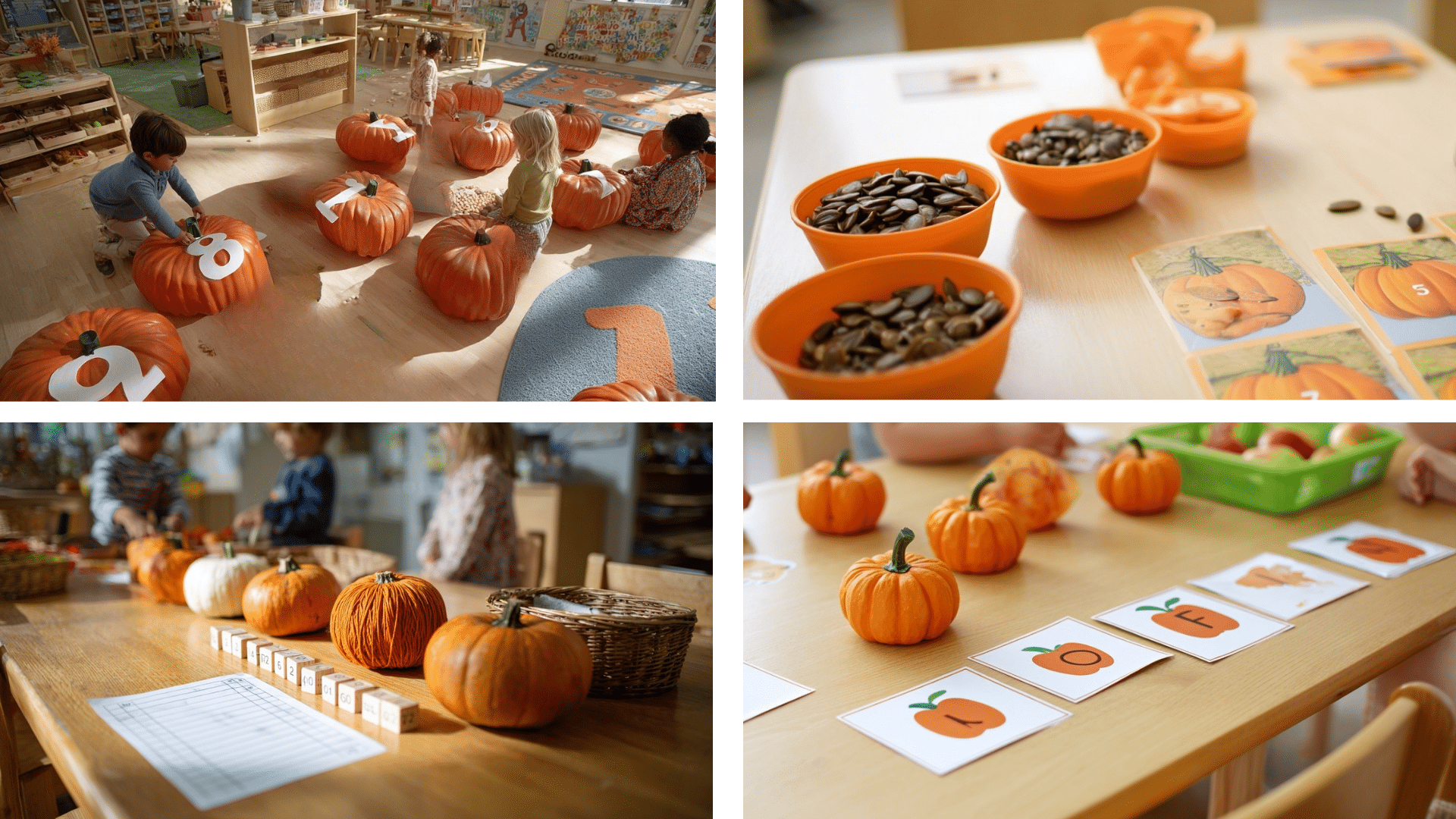
These games turn pumpkins into tools for practicing counting, measuring, and letter recognition. They build early math and reading readiness in a way that feels like play.
12. Pumpkin Seed Counting Cards
Create cards with pumpkins printed on them and numbers inside. Children place the correct number of pumpkin seeds onto each card.
This hands-on activity strengthens number recognition and one-to-one correspondence. You can extend the game by asking children to count aloud or arrange the cards in order.
It also builds fine motor skills as children pick up small seeds, making it both a math and a coordination activity.
13. Numbered Pumpkin Hunt
Hide paper pumpkins around the room, each with a number written on it. Ask children to find the pumpkins and place them in order.
You can also have them match each pumpkin with a set of seeds or counters. This activity combines movement with number practice, keeping preschoolers active while learning.
Extension ideas include using charts to record which numbers they found or practicing simple addition with the collected pumpkins.
14. Measuring Pumpkins with Yarn or Cubes
Provide pumpkins of different sizes along with yarn pieces or unifix cubes. Children can wrap yarn around the pumpkins or line cubes side by side to measure width or height. Record the results on a simple chart for comparison.
This activity teaches measurement concepts, comparison skills, and introduces vocabulary like longer, shorter, bigger, and smaller.
It encourages children to think about size and scale while connecting measurement to a real, tangible object.
15. Pumpkin-Themed Alphabet Match Game
Cut out pumpkin shapes and write uppercase letters on half and lowercase letters on the other half.
Have children match the pairs to build letter recognition. You can also extend the game by placing picture cards with items that start with each letter.
This supports phonics development while reinforcing alphabet awareness. Matching activities like this build early literacy skills and help preschoolers connect letters to sounds in a playful, low-pressure way.
Outdoor & Active Pumpkin Activities
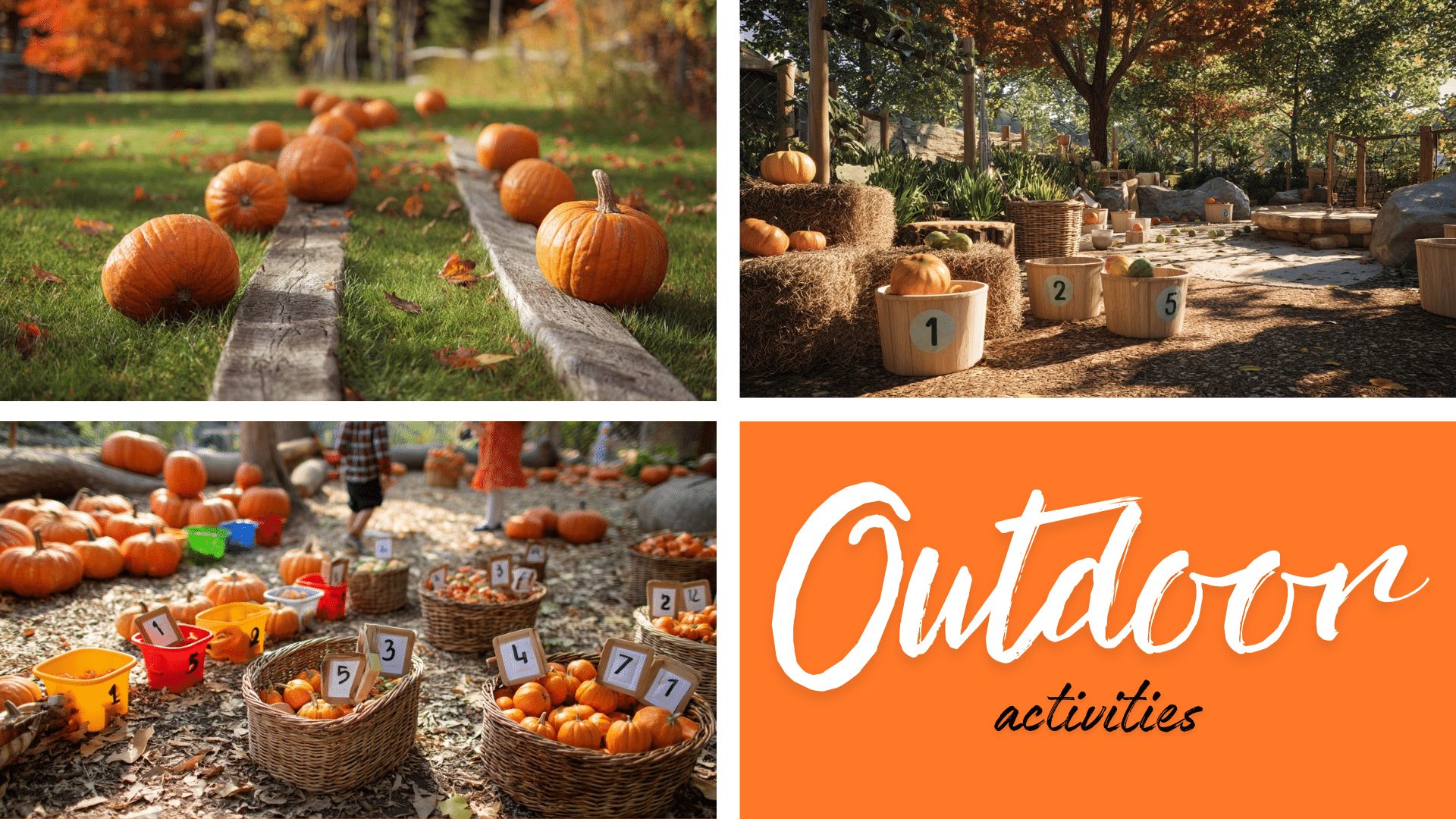
These outdoor activities keep preschoolers moving while using pumpkins as playful props. They encourage gross motor skills, coordination, and active learning.
16. Pumpkin Toss Game
Set up buckets or baskets at different distances and give children small pumpkins to toss inside.
Adjust the distance for an added challenge. This game improves hand-eye coordination and strengthens large muscle movements.
You can extend learning by labeling each bucket with numbers and having children add up their points as they play. It combines physical activity with simple math in a way that keeps preschoolers engaged.
17. Mini Pumpkin Rolling Races
Line up children with small pumpkins and have them roll them across the ground to a finish line. Encourage them to use gentle pushes and watch how the pumpkins move.
This activity develops coordination, balance, and teamwork if done in groups. Teachers can extend learning by asking children to compare which pumpkin rolled the farthest or fastest, introducing early science concepts like speed and distance through observation.
18. Pumpkin Patch Pretend Play
Create a pretend pumpkin patch outdoors with real or paper pumpkins scattered around. Give children baskets and let them “harvest” pumpkins, carry them, and sort them into piles.
This activity strengthens gross motor skills through lifting and carrying while also encouraging imaginative play. To extend the activity, add number cards to the pumpkins and ask children to collect them in order. It combines physical play with counting and sorting practice.
Books & Storytime Activities
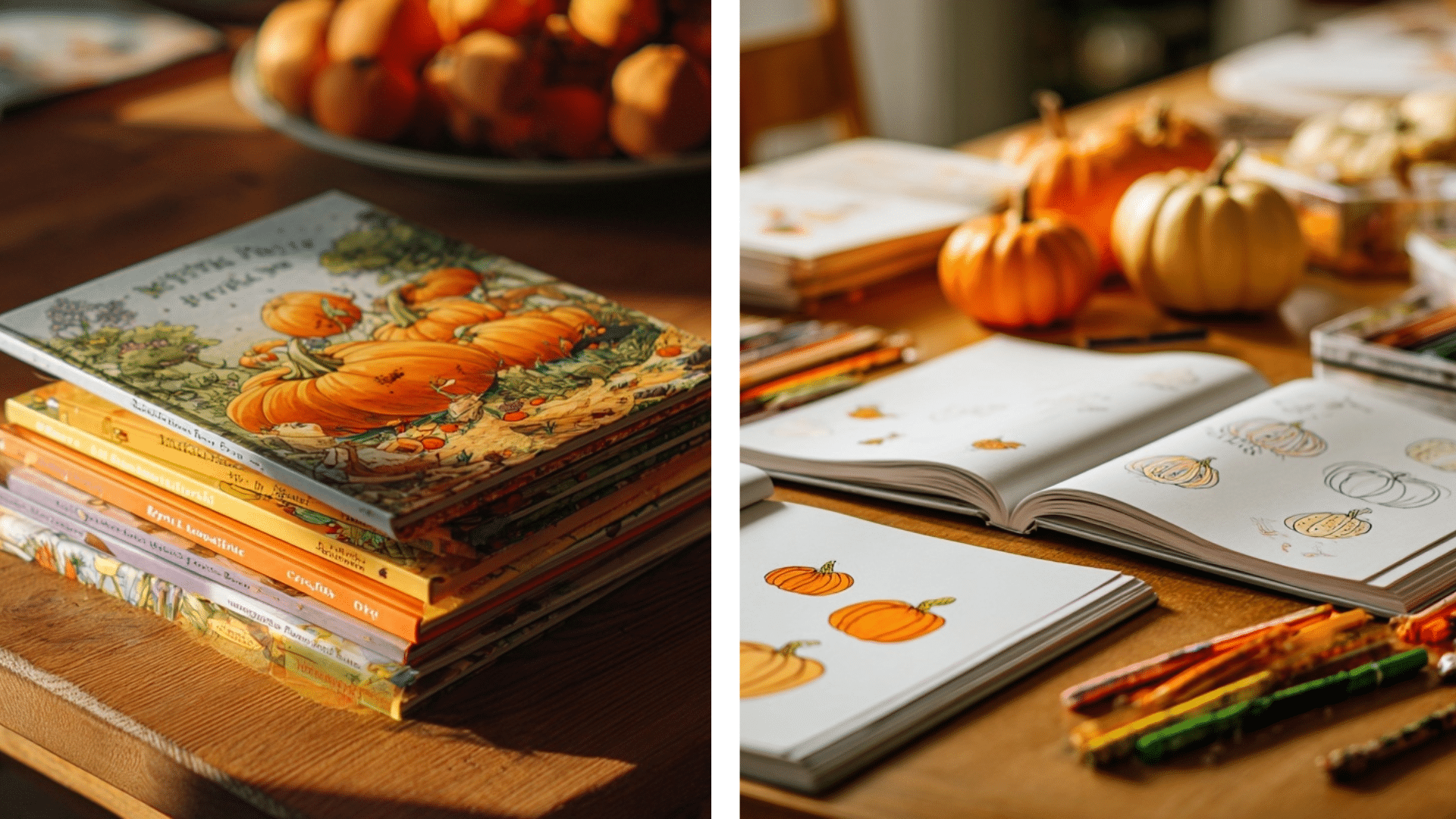
Reading pumpkin-themed books introduces new vocabulary and ideas while connecting stories to hands-on activities. These ideas support early literacy and creativity.
19. Recommended Pumpkin Picture Books
Choose simple, engaging titles like It’s Pumpkin Time! by Zoe Hall, The Very Best Pumpkin by Mark Kimball Moulton, or Pumpkin Jack by Will Hubbell.
These books highlight growth, seasons, and pumpkin traditions. Reading aloud helps preschoolers build listening skills, expand their vocabulary, and develop a love for books.
Pairing stories with activities like seed sorting or pumpkin crafts helps children connect what they hear with real-world experiences.
20. Extension Activities
After reading, encourage children to draw their favorite characters or scenes from the story.
Provide simple props like paper pumpkins, baskets, or felt pieces for retelling the story in their own words.
This builds comprehension, sequencing skills, and confidence in speaking. Teachers can extend learning by asking open-ended questions such as “What happened first?” or “How do you think the pumpkin felt?” These activities deepen understanding while making storytime interactive and fun.
Pumpkin-Themed Cooking & Snack Ideas
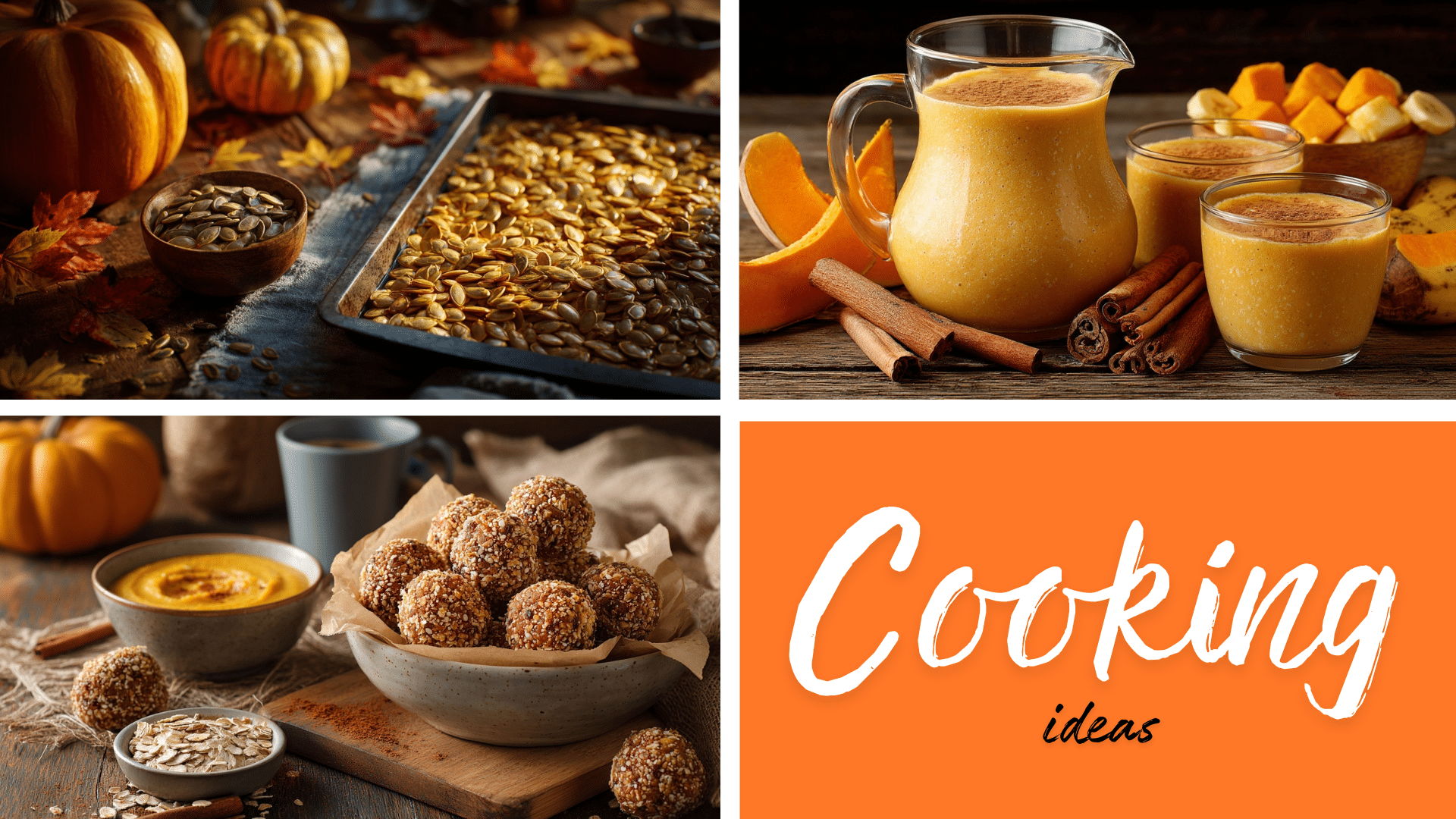
Simple cooking activities with pumpkins give preschoolers a chance to understand food, practice motor skills, and build language while tasting something new. These ideas are safe, hands-on, and fun.
21. Roasted Pumpkin Seeds
After scooping seeds from a pumpkin, let children help rinse them in a bowl of water.
Spread the seeds on a tray, season lightly, and roast until crisp. As the seeds cool, encourage kids to touch and describe their texture, then taste them.
This activity introduces basic cooking steps, supports sensory awareness through touch and taste, and provides a healthy snack children can enjoy together.
22. Pumpkin Smoothie Tasting
Blend pumpkin puree with yogurt or milk, banana, and a little cinnamon to make a creamy fall smoothie.
Pour into small cups for tasting. Encourage children to describe the flavor, texture, and smell, then compare it to familiar foods like apples or bananas.
This activity develops language and descriptive skills, builds confidence in trying new foods, and creates a social experience as children share their thoughts while sampling a seasonal drink.
23. No-Bake Pumpkin Energy Bites
Mix oats, pumpkin puree, honey, and a sprinkle of cinnamon or pumpkin pie spice in a bowl.
Let children take turns stirring, then roll small portions into round bites. Refrigerate for a short time to set.
This activity strengthens fine motor skills as kids roll the mixture, encourages teamwork, and gives them pride in making a snack themselves. It also offers a healthy treat with natural sweetness, making it a fun way to connect food with learning.
Resources for the Classroom
Pumpkin-themed lesson plans and printables make classroom activities easy, engaging, and low-prep for teachers. They save time while keeping kids excited to learn.
- Free printables: counting cards, pumpkin life cycle charts, alphabet games
- Weekly theme plans: mix crafts, sensory play, math, literacy, and movement
- Practical tips: use trays, smocks, and cleanup routines for messy play
With the right resources, pumpkin lessons stay fun and stress-free. A little planning goes a long way in creating smooth, creative learning experiences
Conclusion
Pumpkins offer so many ways to make learning fun, hands-on, and meaningful for young children.
With these pumpkin activities for preschool, you now have a variety of simple ideas that blend play with early learning in math, science, art, and literacy.
They’re flexible enough to use at home or in the classroom, giving you tools to keep kids curious and engaged while celebrating the season.
The real value isn’t just in making crafts or snacks – it’s in helping children , ask questions, and connect new skills to everyday experiences. If you’re excited to keep the seasonal fun going, don’t stop here.


